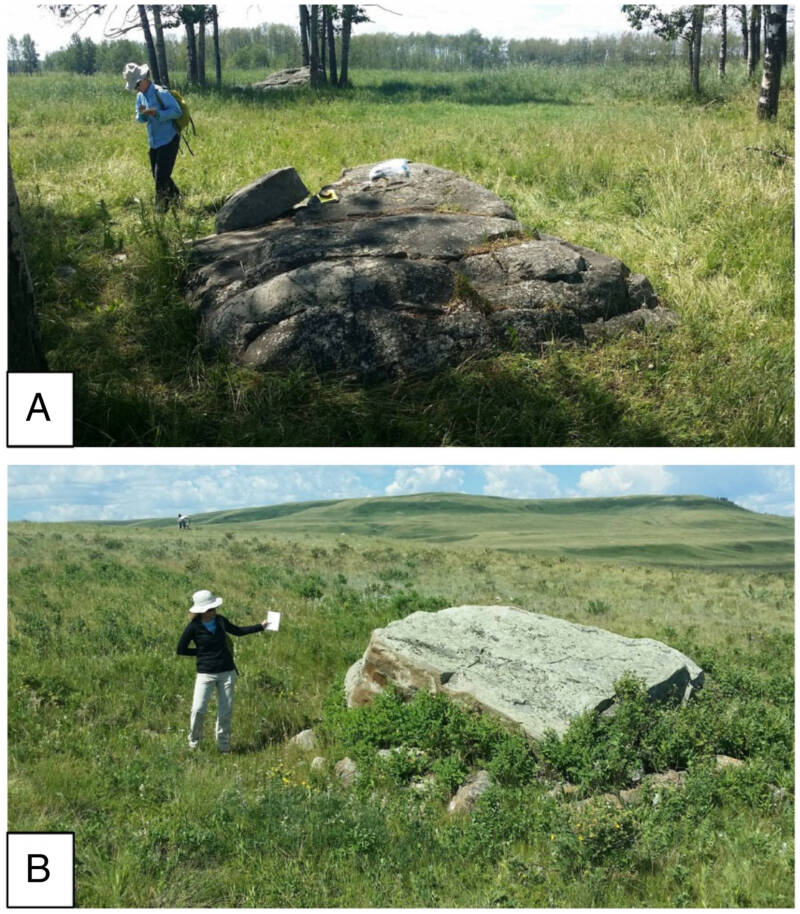The Beringia ice wall measured over a half-mile high and only melted 13,800 years ago — more than 12,000 years after the earliest evidence of humans in North America.

National Oceanic and Atmospheric AssociationThe ancient icy barrier is thought to have been between 1,500 and 3,000 feet high.
Scientists have long suggested that the first people who migrated from Asia to the Americas traveled over the land bridge known as Beringia that connected the two continents. But a new study has posited that this overland route would have been impossible for millennia — as an enormous 300-story-tall ice wall blocked any attempts at passage.
Oregon State University geologist and archaeologist Jorie Clark spearheaded this fascinating new research. He aimed to make sense of the contradictory evidence of when precisely the first people migrated to the Americas.
The study, published in the Proceedings of the National Academy of Sciences, showed that an ice-free corridor migrants supposedly used wasn’t even open until 13,800 years ago. With ancient footprints in Mexico suggesting humans arrived thousands of years earlier, an alternative route must have been taken — which Clark posits was sea-based.
Clark’s new study flies in the face of one of the most widely held theories of early migration to North America. Most researchers once agreed that the first people traveled to the New World when Beringia, a landmass that once connected Asia with North America, was largely ice-free.

National Park ServiceThe research suggests overland travel was impeded by ice and forced early migrants to travel by boat.
According to Nature World News, Beringia served as a stepping stone between Siberia and Alaska. The land bridge was formed during the Pleistocene period about 2.5 million years ago and later hosted animals and ancient humans until glacial melting flooded its routes in the Late Ice Age 11,000 to 10,000 years ago.
Until recently, scientists believed that the first Americans traveled through an ice-free corridor between massive ice sheets, and that this migration occurred before glacial melting made that impossible. Stone tools from 13,400 years ago have long suggested that a prehistoric culture known as the Clovis was the first to do so.
However, recent archaeological finds have challenged that notion. In 2020, archaeologists unearthed stone artifacts in Mexico that were 26,500 years old and found 60 sets of 23,00-year-old footprints in New Mexico in 2021.
To understand when exactly this ice-free corridor opened for migration, Clark took 64 geological samples from six locations across 745 miles of where that corridor supposedly once existed in modern-day British Columbia and Alberta. By analyzing the radioactive elements in these rocks, he determined how long they had been exposed to the sun.
His research team found that the ice-free corridor hadn’t opened until 13,800 years ago and was blocked by colossal ice sheets that “may have been 1,500 to 3,000 feet high in the area where they covered the ice-free corridor.”

Jorie Clark, et al./Proceedings of the National Academy of SciencesTwo of the 64 sites used for geological sampling.
For context, even at its lowest point, the ice sheet would have been taller than the Empire State Building, which measures 1,454 feet to the top of its antenna. And at its highest point, the ice wall would have risen higher than the Burj Khalifa, the tallest building in the world, which stands at 2,722 feet.
“We now have robust evidence that the ice-free corridor was not open and available for the first peopling of the Americas,” Clark told LiveScience.
“There is still a lot to learn about whether they actually did come down the coastal route, and if so, how did they travel. We need to find archaeological sites from the area.”
While these geological findings suggest that massive ice walls impeded an overland route, researchers have yet to find any artifacts supporting the theory that migrants arrived in America by boat.
What’s more, the ocean route would have been challenging, Clarke and his co-authors wrote, noting that the ice wall would have come right to the sea, and “these first peoples would likely still have faced considerable difficulties in navigating the largely glaciated coastline.”

National Park Service/Bournemouth UniversityThese ancient footprints from 26,500 years ago found in New Mexico predate the human activity of Clovis people in the Americas by approximately 12,000 years.
However, according to LiveScience, at least one paleoanthropologist thinks it’s most logical that the earliest humans in the Americas were already here when both land- and sea-based routes were blocked by ice.
“The simplest explanation is that they followed an interior route through the wide ice-free corridor that was present before 30,000 years ago,” John Hoffecker, who works at the University of Colorado at Boulder and was not involved in the study, said.
With stone tools and ancient footprints as evidence, it’s clear that the first Americans arrived far before the Bering land bridge opened. Ultimately, how they got here and precisely how many millennia ago continues to be debated — with only more research allowing us to untangle the ancient mystery.
After reading about the ice wall preventing passage on the Bering land bridge, learn about how the Native American genocide caused an ice age. Then, read about the study suggesting the first Americans arrived 20,000 years earlier than previously thought.





